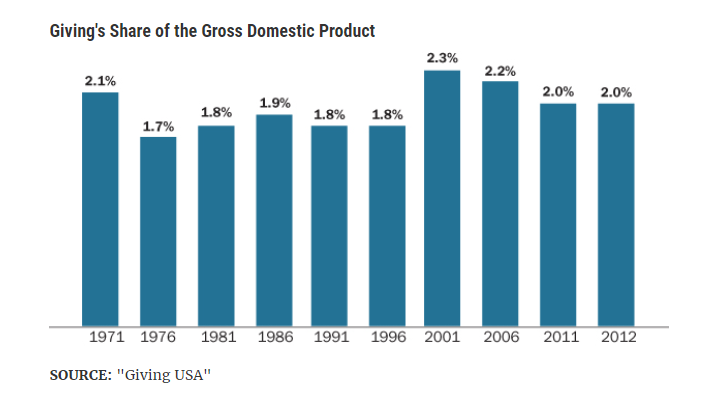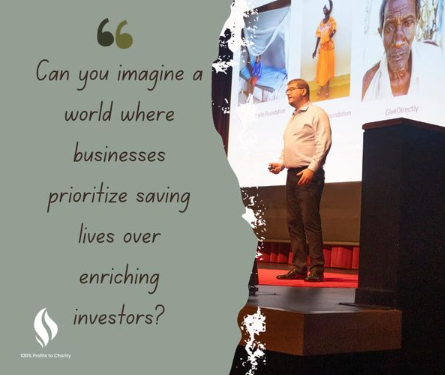There are three key principles guiding (or underpinning) my research framework:
Each of these principles is discussed below.
1. To improve giving outcomes, focus on improving the quality of giving rather than the quantity of giving.
We can think of the good that the charitable sector produces as a function of two variables: the number of dollars given and the amount of good each dollar produces.
Improving the latter variable represents a much larger opportunity. There are huge deviations in impact across charities, creating an enormous opportunity to produce more good by encouraging people to give to more impactful charities.
This thought experiment helps illustrate the point: What would it take to double the impact of the charitable sector?
To do so by changing the quantity of giving would require an unprecedented shift in “the stubborn 2% giving rate”: since 1970, donations in the US have had only minor fluctuations around 2% of GDP. Shifting this rate to 4% seems highly implausible. For context, if we could wave a magic wand and clone every foundation in the US, thereby doubling giving from that category, it would only shift aggregate giving from a baseline of 2% of GDP to ~2.3% of GDP.

Hat tip: Chronicle of Philanthropy
However, doubling the impact of the sector by changing the quality of giving would only require getting ~1% of donors to give ~100x more effectively. In other words, an enormous social benefit could be realized by influencing a relatively small number of donors to give to extraordinarily impactful nonprofits. And that is a tractable problem, particularly if donors who give more than average are targeted.
The first part of a solution to improving the quality of giving involves identifying high-impact charities. Fortunately, there are already a number of reliable actors actively engaged in this work, e.g. charity evaluators such as GiveWell and ImpactMatters, philanthropic advisors, foundation staff, etc. By comparison, the question of how to convince donors to support high impact charities once they’ve been identified remains largely unaddressed. My research framework is meant to fill this gap.
2. The most valuable research is actionable research.
Our research agenda is aimed toward creating real-world change, so we prefer research that can be acted upon by nonprofit practitioners.
Thus given a choice between descriptive giving research (which tells us how donors behave) and prescriptive giving research (which tells us how to create desirable behavioral change), we’d have a strong preference for the latter.
The prescriptive vs. descriptive dichotomy is oversimplified of course; descriptive research can offer an important foundation for subsequent prescriptive research. For instance, initial research that descriptively defined and quantified the “identifiable victim effect” provided the basis for later important prescriptive de-biasing work aimed at mitigating this effect (e.g. here). Actionability is the crucial characteristic and goal.
Many smart people have already invested lots of time, energy, and money trying to convince people to give to more effective charities and progress has not always met intentions or expectations. It’s a tricky problem. We shouldn’t make it any harder than it has to be; rather, we should actively look for ways to make it easier. Examples of how we can do this include:
-
Preferencing research strategies oriented toward demographics that evidence suggests will be receptive to effective giving concepts (e.g. women, millennials, quantitative finance and tech sector employees) relative to the general population.
-
Preferencing research strategies oriented toward demographics with a high capacity to give (e.g. high net worth families, quantitative finance and tech sector employees, foundation program officers).
-
Leveraging existing research on improving giving (e.g. Money for Good reports, meta-analyses of giving literature, etc.)
-
Creating a structured research plan that systematically breaks the difficult overall problem into smaller pieces. For instance, there may be 5 primary obstacles that prevent people from giving effectively. It would presumably be easier to tackle these individually than trying to solve them simultaneously.
-
Promoting coordination between like-minded researchers. If our common goal is to build a vehicle to get us to a particular destination, it’s inefficient to have some people working on a plane, others on a boat, etc. This includes promoting coordination around a shared understanding of the high-level structure of the problems we’re trying to solve; if you’re trying to build a plane, it’s easier if everyone’s working from the same plans.
-
More abstractly, since there are specific outcomes (good giving behaviors) we want to produce, we should focus on finding the most efficient paths that lead to those outcomes. I’ll discuss this idea more in a subsequent post.



